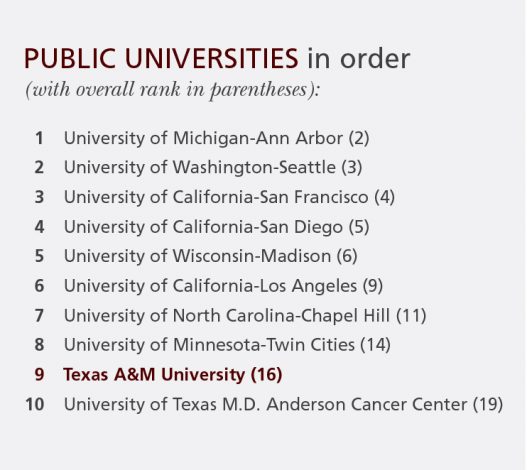Texas A&M University ranks 16th overall among top research universities in latest NSF survey
Video: Research Communications and Public Relations
COLLEGE STATION – Texas A&M University now ranks 16th overall in the latest survey from the National Science Foundation (NSF), based on annual expenditures in research and development.
Released on Nov. 17, the NSF’s Higher Education Research and Development (HERD) survey ranked Texas A&M on fiscal year 2015 reported research and development expenditures of more than $866 million. Previously, fiscal year 2014 expenditures of $854 million ranked Texas A&M 17th overall in the survey.
Among other Texas-based universities in the top 50, The University of Texas M.D. Anderson Cancer Center ranked 19th on the latest survey with $833 million; The University of Texas at Austin ranked 30th with $651 million; the Baylor College of Medicine came in at 39th with $520 million; and The University of Texas Southwestern Medical Center placed 50th with $438.8 million.

In addition, Texas A&M ranks ninth overall among the top-10 public research universities cited by the survey (see chart).
“As Texas A&M rises in the national rankings, we are seeing our investments in recruiting top tier researchers, state-of-the-art facilities and academics pay off,” said Chancellor John Sharp of The Texas A&M University System. “Providing resources is one thing, but I congratulate the faculty, students and administrators for their hard work and focus on groundbreaking discoveries that will change lives and make for a better future.”
Texas A&M President Michael K. Young said, “Texas A&M is owning its seat at the national table in terms of academic excellence and innovation, as reflected in the rankings. We conduct research that changes the course of people’s lives, of their communities, of the world.”
Karan L. Watson, provost and executive vice president, said, “Thanks to our outstanding faculty and their research teams, Texas A&M continues to advance steadily among the top institutions in the nation. Texas A&M conducts research that is vast and deep, cutting across disciplines, engaging in surprising collaborations, and generating results that benefit our state, our nation and the world at-large.”
Glen A. Laine, vice president for research, said, “Every day, our faculty members take on many of society’s most important challenges and produce amazing solutions. Congratulations must go to them, as well as to Chancellor Sharp and President Young for their strong leadership in advancing the Texas A&M research enterprise.”
The NSF survey provides a census of 906 degree-granting colleges and universities in the United States, with a minimum budget of at least $150,000 in research and development expenditures. The latest survey found that U.S. universities recorded $68.8 billion in research and development expenditures in fiscal 2015, an increase of 2.2 percent from fiscal year 2014’s total of $67.4 billion.
The nation’s top three research institutions retained their rankings from the previous NSF survey. Johns Hopkins University led the survey with $2.306 billion in expenditures, followed by University of Michigan at Ann Arbor with $1.369 billion, and the University of Washington at Seattle with $1.181 billion.
Link to Higher Education R&D Expenditures, ranked by all R&D expenditures, by R&D field: FY 2015: https://www.nsf.gov/statistics/2017/nsf17303/
About Research at Texas A&M University: As one of the world’s leading research institutions, Texas A&M is at the forefront in making significant contributions to scholarship and discovery, including that of science and technology. Research conducted at Texas A&M represented annual expenditures of more than $866 million in fiscal year 2015, ranking Texas A&M in the top 20 of the National Science Foundation’s Higher Education Research and Development survey (2015). Texas A&M’s research creates new knowledge that provides basic, fundamental and applied contributions resulting, in many cases, in economic benefits to the state, nation and world. To learn more, visit https://research.tamu.edu.

